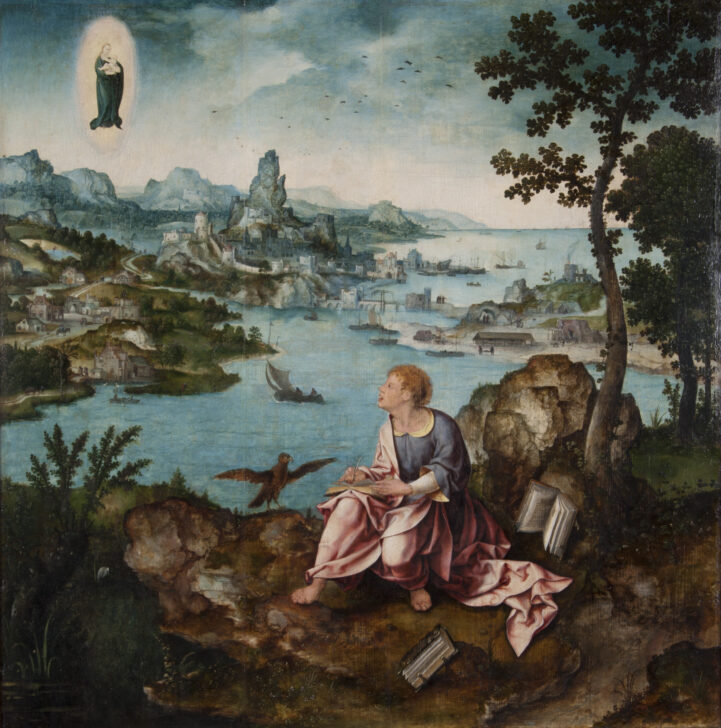St. John the Evangelist on Patmos
Joos van Cleve; Lucas Gassel

Description
March 28, 2009
Here Saint John the Evangelist pauses, with his writing pen poised above the page and his attention arrested by the vision of the “woman clothed with the sun” hovering over the landscape. This celestial figure was described in his apocalyptic Book of Revelation (12:1–3), a work whose soaring visionary character is evoked by the eagle with outstretched wings, perched next to the saint. The celestial woman appears here as the Virgin and Child, which follows a symbolic interpretation of the passage from the Book of Revelation first put forth in the Middle Ages. Behind Saint John, a vast landscape bustles with human activity; it suggests the Greek island of Patmos where Saint John wrote the Revelation while in exile. For sixteenth-century viewers, the busy harbor scene also resembled port cities of their own time, complete with bridges, fortified walls, and church spires. Joos van Cleve perhaps drew inspiration from his home city of Antwerp, an important commercial and artistic center in which he ran a large workshop and enjoyed a position as one of the city’s foremost painters.
Subject Matter:
This painting depicts St. John the Evangelist writing the book of Revelation during his exile on the Greek island of Patmos. A pair of books, signifying the foundations of John's prophecy in the Old Testament, lie at his side, and an eagle, the symbol associated with John, has landed next to him. The saint fixes his attention upon the Virgin Mary who holds the infant Christ and hovers in the sky in a glowing mandorla as the "woman clothed with the sun" described in Revelation (12:1-6). The land falls away precipitously behind St. John and opens into a dramatic panorama of a bustling port and craggy mountains. Despite the great distance of the landscape we can discern, as if with telescopic eyes, myriad details that make the setting resemble sixteenth-century Flanders rather than a remote Mediterranean island.
Physical Description:
St. John the Evangelist sits in the foreground with a book open on his knee and quill pen poised over its pages. Two books rest next to him and an eagle has alighted on an adjacent rock. St. John looks up and to his right to see a standing figure of the Virgin Mary holding the infant Christ, who appear in a glowing mandorla hovering in the sky. A vast panoramic view of a bustling harbor and formidable mountains unfolds behind St. John and extends into the distance.
Usage Rights:
If you are interested in using an image for a publication, please visit https://umma.umich.edu/request-image/ for more information and to fill out the online Image Rights and Reproductions Request Form.